Key takeaways:
- Suspense in film is created through uncertainty and anticipation, engaging viewers by making them confront their fears vicariously through characters.
- Key elements of suspense include timing, unpredictability, and atmosphere, which together amplify tension and keep audiences captivated.
- Techniques for building suspense include strategic silence, false endings, and careful pacing, all of which enhance emotional stakes and maintain engagement.
- Sound design plays a crucial role in suspense creation, with silence and sharp noises effectively evoking visceral emotional responses in viewers.
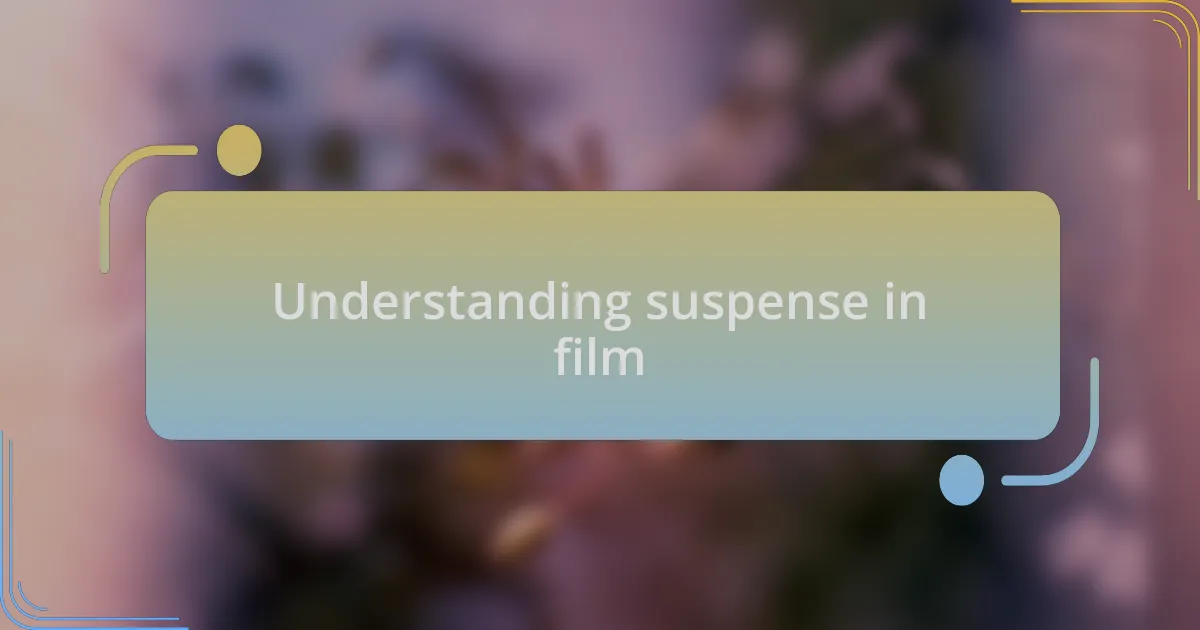
Understanding suspense in film
Suspense in film is all about creating a sense of uncertainty and anticipation. Think back to a moment in a movie where you held your breath, unsure of what would happen next. That tension, whether it’s a character teetering on the edge or a ticking clock, pulls us into the narrative, making us feel connected yet anxious for the outcome.
I remember watching a thriller where every creak of the floorboards seemed amplified, sending chills down my spine. The filmmakers brilliantly used silence and shadows, allowing my imagination to run wild with potential threats. How often do we find ourselves anticipating what may leap from the darkness? That’s the art of suspense: it forces us to confront our own fears and uncertainties vicariously through the characters on screen.
To truly grasp suspense, one must consider pacing and timing. A well-timed pause can leave the audience gasping, wondering if the protagonist will survive. This ebb and flow of tension is precisely what keeps viewers engaged, constantly asking themselves, “What’s going to happen next?” It’s this shared journey of uncertainty that not only captivates but also resonates with our own experiences of suspense in life.
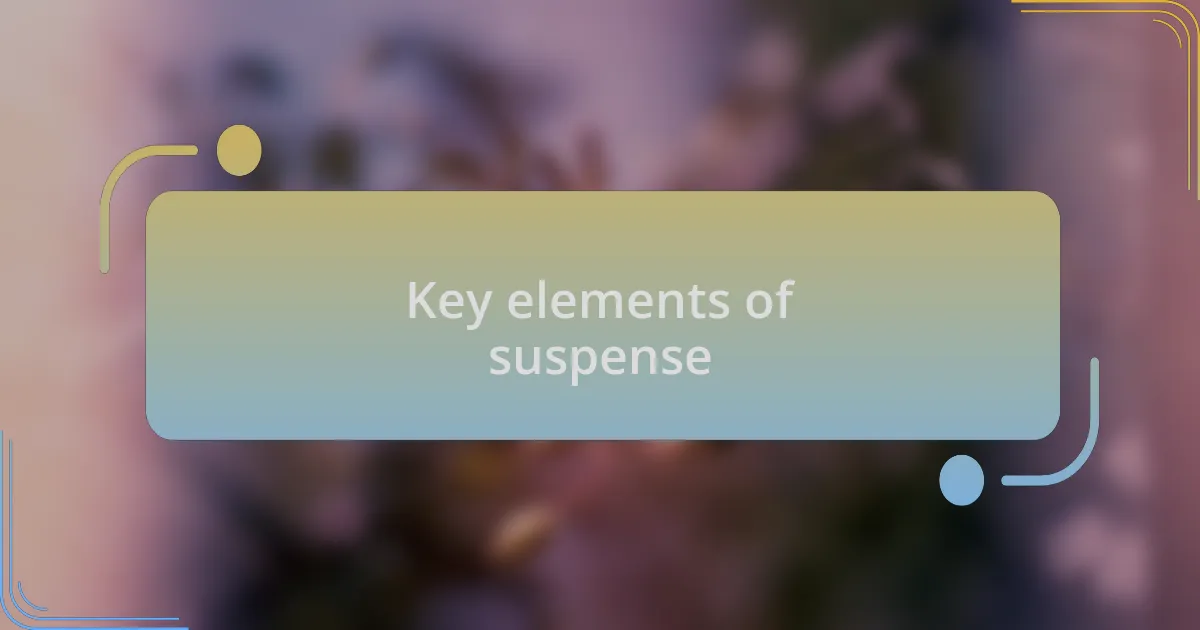
Key elements of suspense
One of the key elements of suspense is the effective use of timing. Have you ever noticed how the build-up to a crucial moment can make your heart race? I recall a scene from a horror film where the protagonist hesitated before opening a door. The extended pause, filled with ominous music, had me on the edge of my seat, gripping the armrest. It wasn’t just the action that created suspense; it was the anticipation that something terrible could happen at any moment.
Another vital component is the unpredictability of events. I think back to a thriller where a seemingly innocent character turned out to be the villain. This twist not only shocked me but also shattered my expectations, illustrating how well-crafted surprises can heighten suspense. Isn’t it fascinating how our minds work? Our brains yearn to predict outcomes, and when filmmakers play against those instincts, it keeps us riveted.
The atmosphere also plays a critical role in building suspense. When I watch films with dim lighting and eerie sound design, I can almost feel the tension in the air. It’s as if the environment wraps around me, amplifying every creak and whisper. Have you felt that chill when a character walks into a dark room, unsure of what lies ahead? That’s the magic of suspense—how it envelops us in unease, making every moment feel significant and loaded with potential danger.
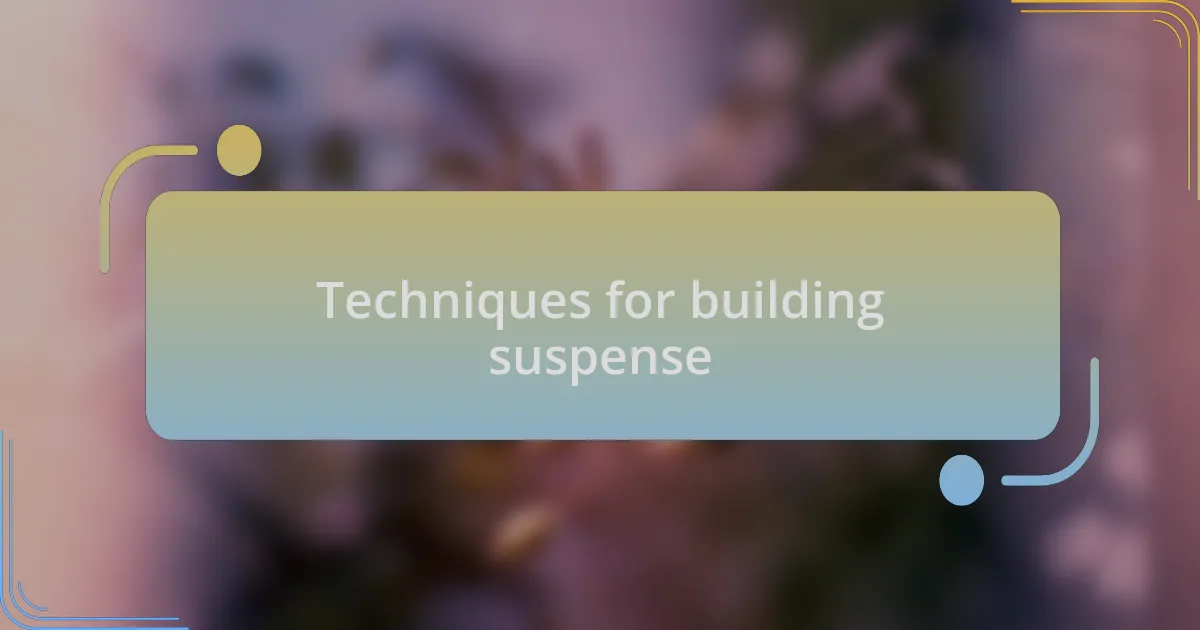
Techniques for building suspense
Creating suspense is an art, and one effective technique involves the strategic use of silence. I remember watching a thriller where the sound suddenly dropped just before an intense confrontation. That silence was deafening; it forced me to lean in, anticipating the climactic moment. How often do we find ourselves holding our breath in such scenarios? Silence can be just as powerful, if not more so, than a loud explosion, as it amplifies our unease.
Another technique is to employ false endings or red herrings. In a mystery film I enjoyed, there was a climactic scene that seemed to resolve the main conflict. Just when I thought it was over, another twist surfaced, leading me deeper into the narrative’s web. This tactic not only keeps viewers guessing but also ensures that there’s always a lingering tension. Have you ever felt that rush when you realize there’s still more to come? It’s a thrill that keeps you engaged and craving more.
Lastly, pacing can’t be overlooked. I once binge-watched a series where the tempo fluctuated between fast-paced action and slow, tension-building moments. This dance of rhythm made the climaxes feel exhilarating and the quieter bits haunting. Don’t you think that finding the right balance is essential for maintaining suspense? When we allow moments to breathe, we create room for dread to seep in, making those exciting payoffs all the more satisfying.
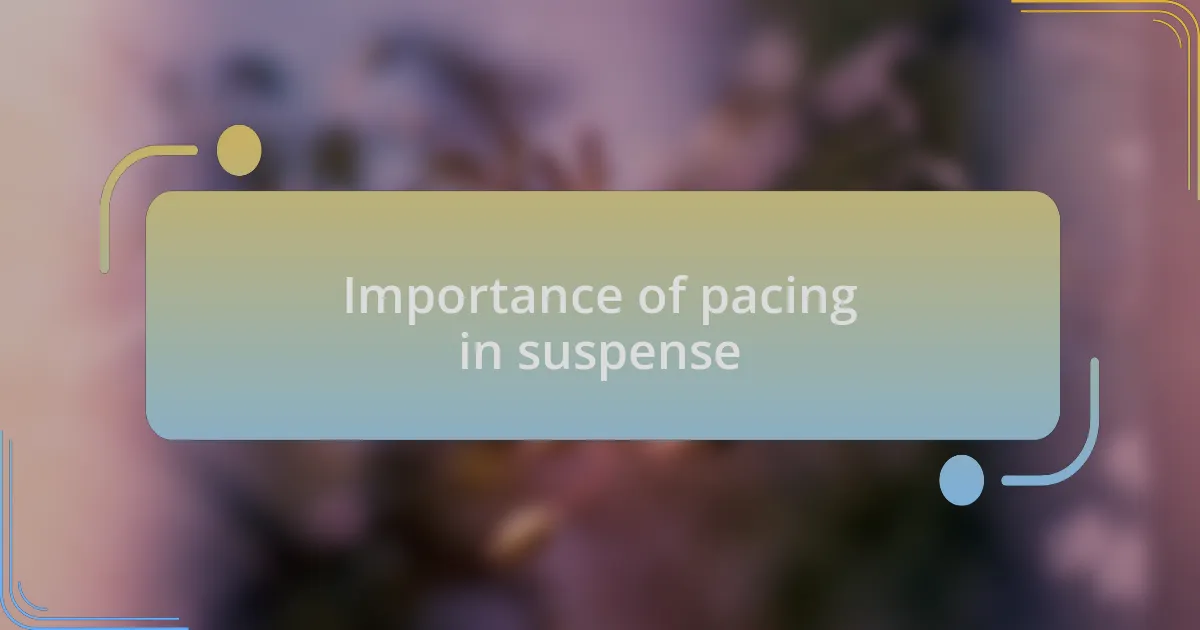
Importance of pacing in suspense
Pacing is like the heartbeat of a suspenseful scene; it sets the rhythm and tone. I recall a film where the director expertly slowed down the narrative just before a pivotal reveal, stretching those few seconds into an eternity. It’s fascinating how that tension can practically pulse through the audience, leaving us on the edge of our seats. Doesn’t that feeling just draw you deeper into the story?
I’ve noticed that the deliberate ebb and flow of pacing can transform a simple scene into a gripping experience. For example, in a horror film I watched, the tension gradually built through lingering close-ups and almost unbearable slowness before a sudden, shocking event. It’s a thrill ride that highlights how the right pacing can enhance the emotional stakes and keep viewers engaged, don’t you think?
In my experience, careful pacing not only heightens suspense but also allows emotions to settle in. There are moments in films where a pause can provide a profound sense of dread—those quiet intervals let the shock resonate, amplifying feelings of fear or uncertainty. When the moments of tension are spaced perfectly, the overall impact feels almost cathartic. Have you ever felt that rush of relief that follows a tension-filled scene, leaving you breathless and exhilarated? That’s the magic of pacing in suspense.
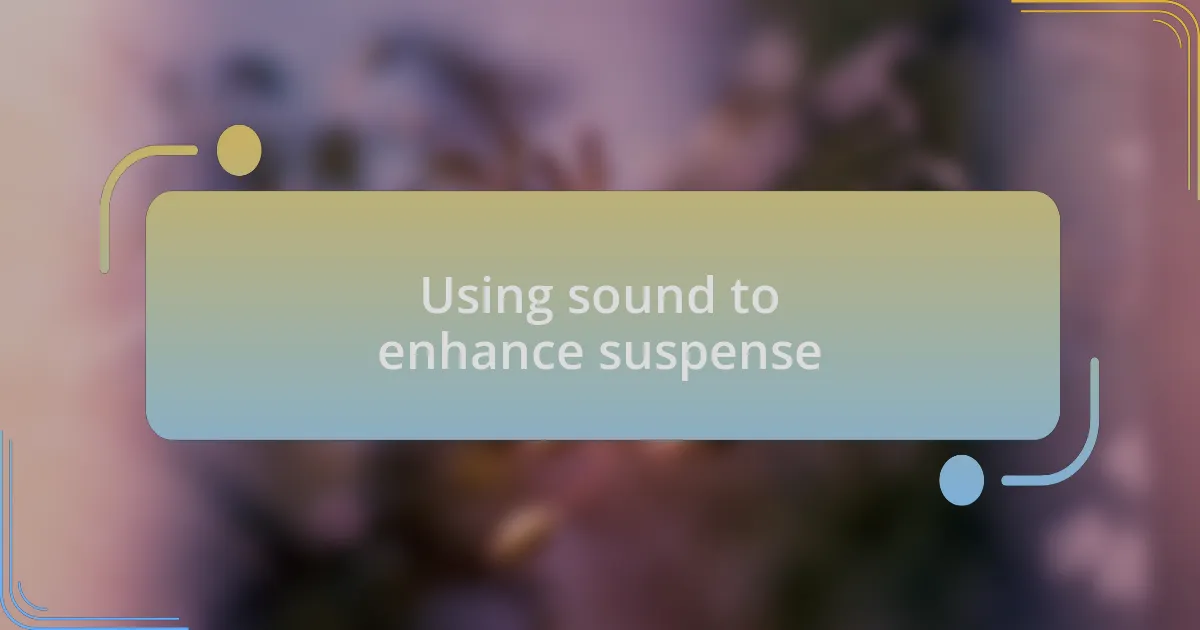
Using sound to enhance suspense
Sound is a vital tool for building suspense, and I’ve seen its power unfold in various film experiences. One memorable instance was in a psychological thriller where the sound design created an ominous atmosphere with low-frequency rumbles. Those subtle, unsettling tones ignited an instinctual response in me, making my skin crawl in anticipation of what lurked around the corner. Isn’t it amazing how sound can evoke such visceral emotions?
In another film, silence played a crucial role in enhancing suspense. There was a scene where the characters were caught in a tense standoff, and the absence of any background noise was almost deafening. I could feel my own heartbeat quickening as the silence created a palpable tension, making every subtle movement feel monumental. Have you ever found yourself holding your breath during a moment where a whispered sound might shatter the stillness?
Moreover, incorporating sharp, unexpected sounds can amplify the tension even more. I was captivated by a horror movie that utilized a sudden loud bang, shocking the audience and drawing us right to the edge of our seats. This technique serves to startle and jolt us, effectively breaking the suspenseful lull. It’s a jarring experience that leaves you wondering what might come next, isn’t that the essence of great storytelling?
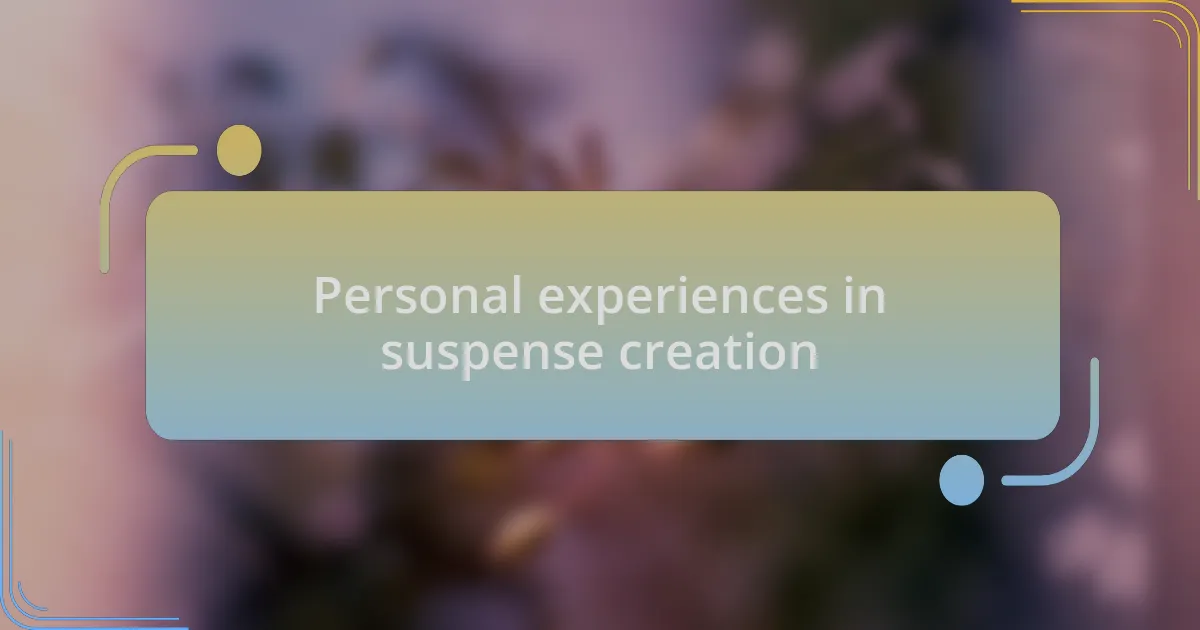
Personal experiences in suspense creation
As I think about my own experiences in creating suspense, I recall a particular short film that relied heavily on pacing. We had a scene where the protagonist was hiking through a foggy forest, and I chose to intersperse brief moments of action with prolonged stretches of quiet. The ebb and flow of the narrative made the audience lean in closer; they didn’t just watch the film—they became invested in what would happen next. Have you ever noticed how a well-timed pause can make you hold your breath, heightening the anticipation?
In another project, I experimented with lighting to evoke a sense of dread. We shot a crucial scene in near darkness, relying on flickering shadows to suggest unseen threats. I vividly remember watching test screenings and observing the audience’s reactions. Their gasps at the brief flashes illuminated something I had instinctively known: darkness can terrify more than any reveal can. It left me wondering, how deeply does our imagination fill in the gaps when we can’t see everything?
There was also a time when I used character-driven tension to build suspense. In a thriller, we developed a manipulative character who constantly kept the audience guessing about their true intentions. I loved how cast members brought an emotional depth to their performances; each unsettling glance and cautious word enriched the story. It made me realize that sometimes, the fear of the unknown can create a thicker atmosphere than any physical threat ever could. Isn’t it fascinating how the human psyche thirsts for answers, yet often fears what it uncovers?